CD – 8 tracks – 43:10
Photography & Design: Jon Wozencroft
Mastered by Denis Blackham
The Japanese phrase ‘Kiri No Oto’ loosely translates to the ‘sound of fog’ or ‘sound of mist’. In many ways it’s a collection that meditates on the sense of displacement and distortion that occurs in environments which undergo extreme mists, snowstorms and sea sprays. In the same way that visual objects loose their perspective, form and shape in these environments, the sound components that make up Kiri No Oto are not quite as they first might appear.
Utilising a range of divergent mixing techniques, analog filtering and ‘harmonic’ distortion, Kiri No Oto offers an expansive sound space in which the listener must choose to position themselves. Focus, like that in a fog, is in a constant state of flux as elements are brought into and out of perspective.
The first in a series of records employing this technique, Kiri No Oto explores the richness in the frequencies that are usually associated with extremes of volume and through this process the recordings position ‘the ear’ itself as ‘another layer of auditory fog’ as it begins to distort and alter the sounds it comes in contact with.
The sounds sources for Kiri No Oto emanate from both instruments and found sound, with recordings on this edition made in Poland, New Zealand, Australia and Japan.
Track list:
1. Organs Lost At Sea
2. Soft Fuse
3. White Spray
4. Waves Sheer Light
5. Commentary
6. Allay
7. Figure’s Lone Static
8. Oamura
Reviews:
Brainwashed (USA):
The man behind the Room 40 label makes his debut on Touch with this remarkable album. Blurring sound sources (both regular instruments and field recordings) with a variety of studio techniques, this Australian has created a swirling and amorphous group of compositions. Every moment on this album is captivating. Each piece is an exercise in sound sculpting perfection and yet is not just textbook examples of audio manipulation; the music is completely aesthetically pleasing.
Touch
The album’s title is Japanese for “sound of fog” and, listening to the music herein, it is easy to see why English used this phrase. The sounds here are dense and pervasive but at the same time they are ethereal, never coagulating into a solid force. It is up to the listener to orientate themselves in this vapour as English deploys a number of post-production techniques (analogue filtering, divergent mixing and distortion) to smear his original source sounds into this auditory fog. He leaves no landmarks and there is no trail of breadcrumbs to fall back on. However, the result of this is not a terrifying solitude in limbo but a feeling of travelling through a cloud without the aid of machinery; floating in isolation in an almost amniotic environment.
From time to time, sounds make it through English’s fog (an organ here and natural sound there) which pulls me back down to reality (or could be phantom artefacts generated by English’s production technique). The sound of the sea on “White Spray” is as close as it gets to a tangible reality before fading off into the distance. Alien atmospherics on “Allay” give the feeling of being far, far from home. It would be no surprise if those strangely fluid mechanical sounds were the utterings of some benevolent being resting in the periphery of this auditory pea souper.
What makes Kiri No Oto work so spectacularly well (and it is a spectacular album) is that no matter what situation I’ve listened to it in and no matter what sort of sound system I use, it still sounds phenomenal. Not that it sounds hi-fi on all formats but everything from my stereo system at home, my car stereo and right down to an iPod broadcasting into a nearby mono radio channels the music in a unique way. It surpasses the usual idea of ambient music (i.e. that which becomes part of the surroundings and is ignorable) as it subverts the ambience of a room (or car) and redefines the sonic space thereof. Instead of fitting the room, the room is made to fit it which fits in perfectly with English’s approach to designing these pieces, namely filtration and mixing.
As this is supposed to be the first in a number of experiments using these techniques, I am eagerly awaiting the follow ups to this wonderful album. It is a rare thing to hear an album that is so engaging and stimulating; that it is just the beginning of an ongoing work is joyous news indeed. I sincerely hope that all of the subsequent releases live up to the standard set by English with Kiri No Oto but even if they pale in comparison, the fact that this exists is more than enough.
The Silent Ballet (USA):
Nature, even after scientific development, remains mysterious as it’s always been, albeit in different ways. To avoid confrontation with the unknown and fall into a perpetual state of fear, we grant nature a very human front; we make familiar that which otherwise might be completely alien and incomprehensible. For example, when we say that birds are singing songs, language is making those specific sounds and chirps they use to communicate into something we can tangentially understand, because birds don’t really sing, and they don’t compose songs either. At work are our minds trying to establish a comfortable space in which we lead a certain understanding of a distant Nature, a Nature that confronts us with sensorial experiences of all kinds, from which Lawrence English parts, allowing us to ask a question: “Can we understand?”
Kiri No Oto is Japanese for “the sound of fog;” the choice of language already implies a distance, an enigma that not many of us can understand at first, unsuitable for translation, something that we won’t ever be able to fully express in our own language. In a metaphorical sense, that is Nature, and it produces countless mysteries which constantly assault our senses and perception as wholes, just like “the sound of fog” is a description of a full spatial experience, both visual and audible. Through technology we’ve shielded ourselves from such attacks, keeping Nature well-trimmed, domesticated, paradoxically drawing ourselves ever more apart from it while at the same time getting closer. Lawrence English has crafted a work that represents this well: he takes us into the territory of the fiercely uncontrollable through the use of analog filtering and a diversity of mixing techniques, all human-controlled, all representative of Nature as interpreted by man through the use of machines. This Nature, in first instance conceived as an abstract other, acquires physical form: the mist, the rain, the ocean, the things that immediately strike us when we set our eyes on them, and interpretation begins.
The artist makes this focus clear with the thunderous introduction “Organs Lost At Sea,” its overpowering magnificence driving our senses numb into an awe-inspired paralysis, an organic wall of sound streaming through our minds and replacing any and all coherent thoughts with the electronic and metallic visual contemplation of an ocean of sound. This is modern man’s Nature: the city, the machines, the static, the street lamps outshining the stars. Electronic sound waves leave no room for silence; just like urban life, “Short Fuse” fills our ears with hums and distant frequencies. “White Spray” becomes a dual-sensed track: we could imagine the ocean’s foam spraying over the rocks it crashes upon; but we could as well think of industrial-use white spray paint, with its equally intermittent bursts of violence attempting to cover up everything in its path in an unconscious reflection of our fear to the void, our fear of dark, silent nothingness. Fortunately, the artist “Waves Sheer Light”, guiding our minds through a narrow tunnel of soundscapes which immerse us in pure, unadulterated loneliness; the loneliness of lacking a translation, the loneliness of facing Nature and finding out it’s not as familiar as you may have thought.
With a smooth and clear transition, the artist decides to intervene, in a metaphorical voice, making his “Commentary:” you’re not alone, in the background you can hear the calming sound of the sea, and it’s all part of the artist’s discourse, now revealed… you can finally pull yourself out, and rest. For that he plays a “Lullaby”, and you can hear a meditative, ritualistic chant that makes you company… until you find out it’s not sung by real voices: they’re machines, the same machines that with hums and beeps and warming electricity lull you into sleep, replacing the apparent necessity of silence, maybe even becoming a new kind of silence themselves.
In that sleep, you find yourself “Lone by Power Station;” the distortion makes an appearance, it’s the ethereal confusion of the supposedly blank moments before and between dreams which hint at something that vanishes just as quickly as neuronal electric impulses. Your brain is working in mysterious, machine-like ways, powering your dreams, your R.E.M, keeping your organs in order while it lets the body rest and recover. “Oamura” (a New Zealandese town) closes the album with a return to the sea; this time the sea of the unconscious, the self-induced trance of contemplating Nature, our century’s mechanical version of it, washing away in the background electronic tension of our dreams.
Kiri No Oto reveals itself as a mirror of that Nature which we’re no longer a part of, but which we have absorbed, imitated, and controlled to some extent, creating our very own modern version. The problem is that it may become monotonous after the excellent first impression of the beginning tracks wears off, sounding (oh, the fear!) like nothing, allowing us to get lost in the endless waves of sounds. This is music that demands focus, but then again, it may induce distraction, especially if not listened to in a quiet, lonely place.
(Un)Fortunately, thanks to modern times, we’ve got plenty of those. And even then, we’re always in the company of the hums, drones, and mysterious functioning of all those machines we can call, unlike Nature, our own. [David Murrieta]
WNYU Chart for August 11, 2008 [USA]
Compiled by Music Director: Kayla Cohen
1. Lawrence English – Kiri No Oto (Touch)
There is an interview with Lawrence English in Artforum (US) which you can read here
Boomkat (UK):
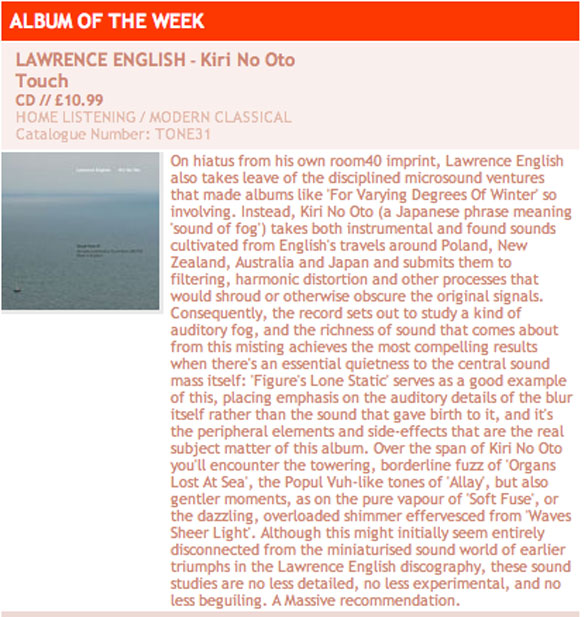
AVUI (Spain):
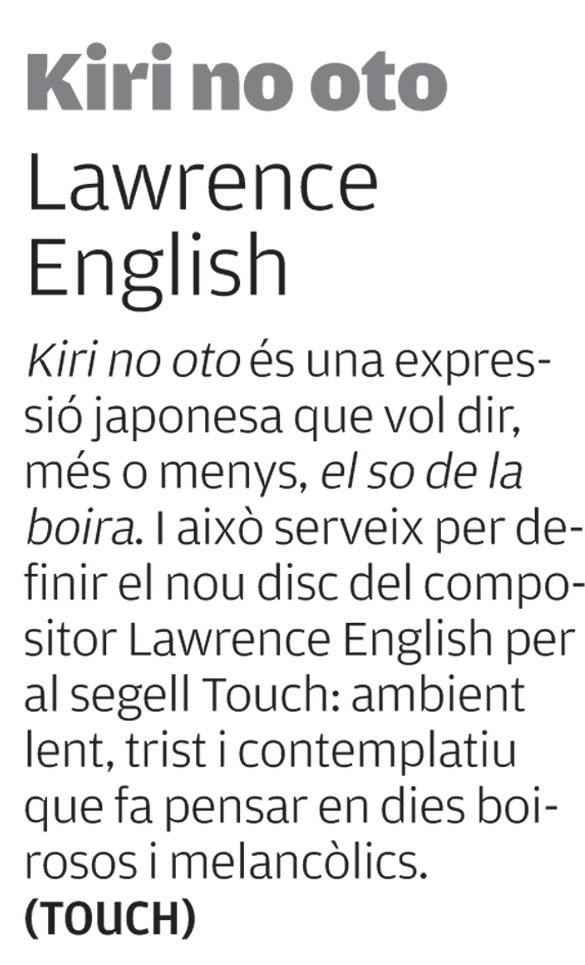
VITAL (Netherlands):
Perhaps Lawrence English needs no introduction, as recently he has presented much new work in these pages. He is from Brisbane where he deals with field recordings, installations, improvisations with people like David Toop, Terry Riley, DJ Olive, Tetuzi Akiyama and many others. Also he is the man behind Australia’s more interesting labels Room40. In his own music he uses a lot of field recordings, like his recent underwater recordings. On ‘Kiri No Oto’, which translates as ‘sound of fog’, which is not what he uses, but the music that sounds like fog. Although English doesn’t reveal his sound sources, just referred to as ‘instruments and found sounds’, which are processed until they sound like fog. Also the processing is just described as ‘analog filtering and harmonic distortion’, but the end result works very much like fog. No matter how hard you try to see, all you get is blurry things. And that’s what this music does too. Once you think you may recognize something – be it a melody, an instrument or even a melodic part such as ‘Allay’ – it’s never really clear what it is that you are listening to. I’m not a car driver, but I can imagine this as driving a car in fog: you notice things, and then they disappear and as such works the music also. Each of the eight pieces work like this, each piece of music has its own special quality, even when there are similarities among the various pieces. Here the fog theme works also a bigger level – by creating similar yet different tracks, a deliberate mist is also created. Great record, if not always surprising from the perspective of ‘new’ music. [FdW]
Other Music (USA):
Kiri No Oto is a gorgeous attempt at the sonic transposition of “the visual effects of mist, mirage, snow fall and the like” from Australian soundsmith and room40 label-founder Lawrence English. While the title — translating loosely to “the sound of mist” or “fog” — or mission statement might suggest that tranquility or minimalism’s ahead, this album is more often than not a downright stormy one. Not to mention gorgeous. As with any Touch release, don’t let the grays of the Jon Wozencroft cover photo get to you; English draws from an amazing sonic-color palette, his sounds fluid, vaporous, and shimmering, his application of field-recordings from the world over amazingly transporting. Kiri No Oto is a piece of sound art operating at a far distance from impressionism — English does not attempt to paint us pictures of foggy landscapes or snow storms, so much as he attempts to capture us in environments similarly sublime. [AKa]
White Line (UK):
Perhaps better known for audio works on his own imprint, Room 40, and a series of live excursions which took in a good portion of Europe last year, Lawrence English makes his debut on Touch in the form of a drone piece, Kiri No Oto, which loosely translates as “the sound of fog.”
Perhaps “drone piece” is far too limited a description, as English’s tonal assemblages are complex, dense, stratified affairs, consisting of various forms of instrumentation, particularly organ- based drones, juxtaposing pointillist cascades of tonalism against a fabric of overtones and amorphous harmonics. These aural texturologies present us with no surprises, no hidden spectra, no glitch or fuss, just sheer minimalist bliss, ebbing and flowing in irridescent waves and crescendos.
Some of the sounds are infused with an edgy patina, the almost industrial overtones entering into White Spray come to mind, but these are quickly dissipated, filtered, and numbed, creating a fascinating dynamics of harsh and soft tones. These shifting, sedimentary layerings create areas rich in colour and texture that shine through on occasion, glimmers of sunlight filtered through the fog of texture, intriguing and beguiling at one and the same time. Figure’s Lone Static emerges as my track of choice, moving from soft pastel renderings, panning across the soundscape, that gradually swells and envelops the listener in a fully immersive and gritty tonal assault – wonderful stuff.
Touch have chosen well here, as Kiri No Oto acts in symbiosis with their organ based Spire releases of late, and also the work of label mate, Rosy Parlane could be a spiritual benefactor. Intelligent drones from an established and now highly influential figure on the minimalist scene… essential. [BGN]
mapsadaisical (UK):
As ridiculous as it may sound, for several months now I’ve actually had no functioning stereo, the CD player having long since skidded to a shuddery halt. I know it is going to take me months of reading reviews, attempting to triangulate qualitative evidence across various independent sources, and flicking through shiny metal box-porn magazines full of adverts for these warehouses based in Kent with prices which just say £CALL, whatever that means, before I’ll even think about parting with any GBP for a replacement. I’m quaking with dread just thinking about the process. Maybe it was that terror which made me want to feed this new Lawrence English CD into the malfunctioning machine, but after a bit of chatter and chirrup, the dumb beast burst into life, and the room was filled with a lush roar. I turned the volume up until the room shook. Kiri No Oto is Japanese for “sound of fog”. Now hailing from the north east of Scotland, fog is something I have plenty experience of, and I must confess that it has never filled me with the pleasure that I got from listening to this disc at high volume. In fact, even listening at more restrained decibel levels it sounds loud, such is the level of distortion that English has applied in his efforts to simulate the effects of particularly inclement weather conditions. First track “Organs At Sea” sets the tone gloriously, with thick churchy drone submerged under huge washes of static – it sounds like something you would find on a Tim Hecker album. After a couple of minutes of ominous atmospheric conditions, “White Spray” erupts with malevolence, sounding like a ill-advised mixture of water, metal and electricity. The lush ringing tones and vaguely recollected melodies buried deep within “Waves Sheer Light” are reminiscent of fellow Touch resident BJ Nilsen; later “Allay” supplements this palete with some disturbing, hard-earned electronic breaths. Kiri No Oto ends with “Oamura” being slowly gouged away by a raging tide until all that remains is the sea, thrashing away invisibly behind the curtain of freezing fog. My CD player hasn’t bothered to play anything since, but if that was to be its swansong, what a way to burn out: I’ll remember those forty-three minutes for quite some time. Give it a go yourself with a copy from Touch: truly, Kiri No Oto is not to be mist.
Gonzo Circus (Belgium):
Het Britse Touchlabel houdt al jaren vast aan een kleine, maar uitmuntende artiestenstal. Met ‘Kiri No Oto’ van Lawrence English brengt men nieuw talent aan de oppervlakte. Niet dat de Australiër uit Brisbane een volbloed nieuwkomer is. English bracht eerder al werk uit op Baskura, Cajid en Crónica. Maar verdiende vooral zijn sporen met zijn eigen label Room40 dat in korte tijd uitgroeide tot een referentie binnen de wereld van soundscapes en musique concrete. ‘Kiri No Oto’ betekent in het Japans ‘het geluid van de mist’ en het is vanuit dat idee dat English vertrekt. Dikke geluidsgolven, fieldrecordings die hij maakte van de oceaan, vormen de basis, maar worden minutieus ingekleurd. Wat ons vooral intrigeerde was het breekbare evenwicht tussen postklassieke muziek en soundscapes. English dropt de luisteraar in een nieuwe biotoop en verplicht hem om positie te kiezen en een eigen parcours uit te stippelen. Wie zijn klasseplaat ‘Happiness Will Befall’ op Crónica kent hoort een heel ander geluid. Speelde English op ‘Happiness Wil Befall’ nog nadrukkelijk met het element stilte, dan overheerst hier een vloedgolf, toepasselijker een oceaan, aan geluiden. Een innemend werkstuk. [Peter Deschamps]
Resident Adviser (USA):
However distantly, ambient music always seems intrinsically linked to nature, an alternative soundtrack to the constant hum of our shared space. So when Lawrence English—founder of the room40 imprint—entitled his Touch debut Kiri No Oto, a Japanese phrase for “sound of fog,” it seemed like a sensible connection, invoking a visual sensation that might easily translate into music.
Combining field recordings from Poland, New Zealand, Australia, and Japan with organ sounds, analog filtering, and harmonic drone sections, English has created an album just as transporting as the fog- and oceanscapes he’s exploring. Dense coils of distortion coalesce into diffuse, light-streaked passages, revealing undulations in balance that waver between eerie calm and new motion. English creates a head space for the most foreign elements of the natural world, embracing the kinetic surf and blow of mist while respecting its natural lethargy, its willingness to shift and dip without overcoming its environment.
But English is rarely content with long gliding organ tones, or the overwrought emotional aspects his subject might too easily evoke. His compositions evolve in the unclockable time of the outdoors. He keeps them in a constant flux that mirrors the unpredictable calms and clamors of his environment. He depends on subtle countertextures to expose anything that glistens or reflects too much to the sandpapering of salt-air. The uneasy textures of opener “Organs Lost at Sea” break unexpectedly, giving into the morning-after spell of “Soft Fuse.” “White Spray,” with its caustic squalls of noise, is sifted into the distant church-like tones of “Waves Sheer Light,” which achieves the lightless illumination feel of anything seen through a cloak of fog or mist.
“Lullaby” is even murkier, with its harmonic elements contrasted by a deep, dim racket like something banging against sunken metal, hidden beneath the sea. Ostensibly the subtlest piece here, “Figure’s Lone Static” is busier beneath the surface than you first think, twisting bristling noise into a repeating, two-tone organ part until they both dissolve into “Oamura”‘s leaden drones. As always with English’s work on Kiri No Oto though, it’s structured to feel like its testing the limits of its own atmosphere without really moving, lapping at the spots where the water’s warmer, the air more breathable. [Derek Miller]
Forest Gospel (net):
Lawrence English, label head of Australia’s Room 40 imprint, has let his most recent solo album loose on the equally superb Touch label. Perhaps it is just a means of rest to go through Touch or perhaps a general nod to the label’s similar knack for progressive sound artists, either way Kiri No Oto adds an incredible cog to the Touch catalog and is deserving of a well won vacation because English is at the top of his game here. Listening to Kiri No Oto is as brooding, hazy and indistinct as walking through an endless mist of varying shades of grey. English must have been well aware of this when naming the album seeing as how its Japanese translation is something like ‘sound of fog.’ You’ll just have to listen to discover how incredibly apt that title is. English works with a veritable wall of sound that is simply awash with brick after brick of slowly oscillating white noise. Extremely layered and smartly composed, tracks like “White Spray” and “Allay” break through the standard muted drones with surges of industrial squalor. The basis of the sounds manipulated here is a whole ‘nother story as well with the building blocks of Kiri No Oto coming from both found sounds and instruments of far reaching locals from Japan to Poland that English harvested through his own travels. English may not have the same name recognition as contemporaries like Tim Hecker and Fennesz, but Kiri No Oto is definitely a statement that stands with the likes of Harmony in Ultraviolet and Endless Summer. Just check the album cover, it sounds like that. [Mr. Thistle]
de:bug (Germany):
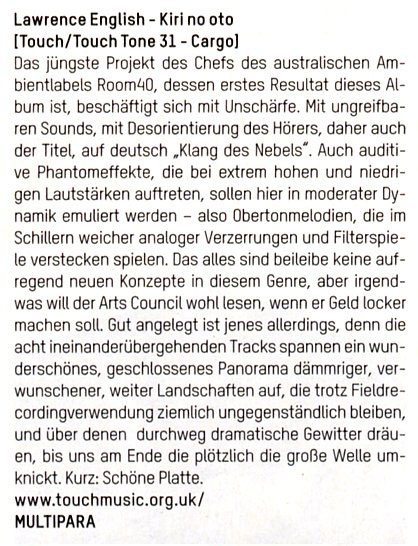
Paperthinwalls (USA):
Although Australian drone artist Lawrence English clearly loves nature, it always seems to take on the properties of a movie monster in his music, sucking you dry or lurking like a sinister fog. His last album, For Varying Degrees Of Winter painted snowfall in all its hazy shades, from Koner-style desolation to Fennesz-touched blizzards. And even more, he loves putting listeners in lifeboats: 2006’s field recording experiment, Happiness Will Befall, featured the chilly, windy, ocean-sick Ambarchi doom of “Adrift” and 2005’s Transit had the even more stark “Oceanic Drift,” which was almost Lustmordian in its lo-velocity fever-sulk. For his latest album—and first for English sound champions Touch Tone—Lawrence moves from floating on the lapping water to forcing you to suck it into your lungs by the warm, unforgiving mouthful. The title “Organs Lost At Sea” is a little overly cute—but damned if it isn’t a curiosity-piquer and damned if it isn’t accurate. Kicking off the album with an enormous, deafening blast of gray drone, it’s English coming moodier and more aggressive than ever before, an mellow Eno dude turned provocateur out to suffocate every inch of your speaker. Kiri No Oto (translation: “sound of fog”) is an album he says is “concerned with transposing the visual effects of mist, mirage, snow fall and the like to a variety of acoustic situations.” But really it just sounds like he’s making the big move, turning the audience from “listener” to “participant,” giving us an abusive monolith of sound for us to treat like an immersive installation, taking in the big picture instead of analyzing the laptop brush strokes. Play loud. [Christopher R. Weingarten]
Laif (Turkey):
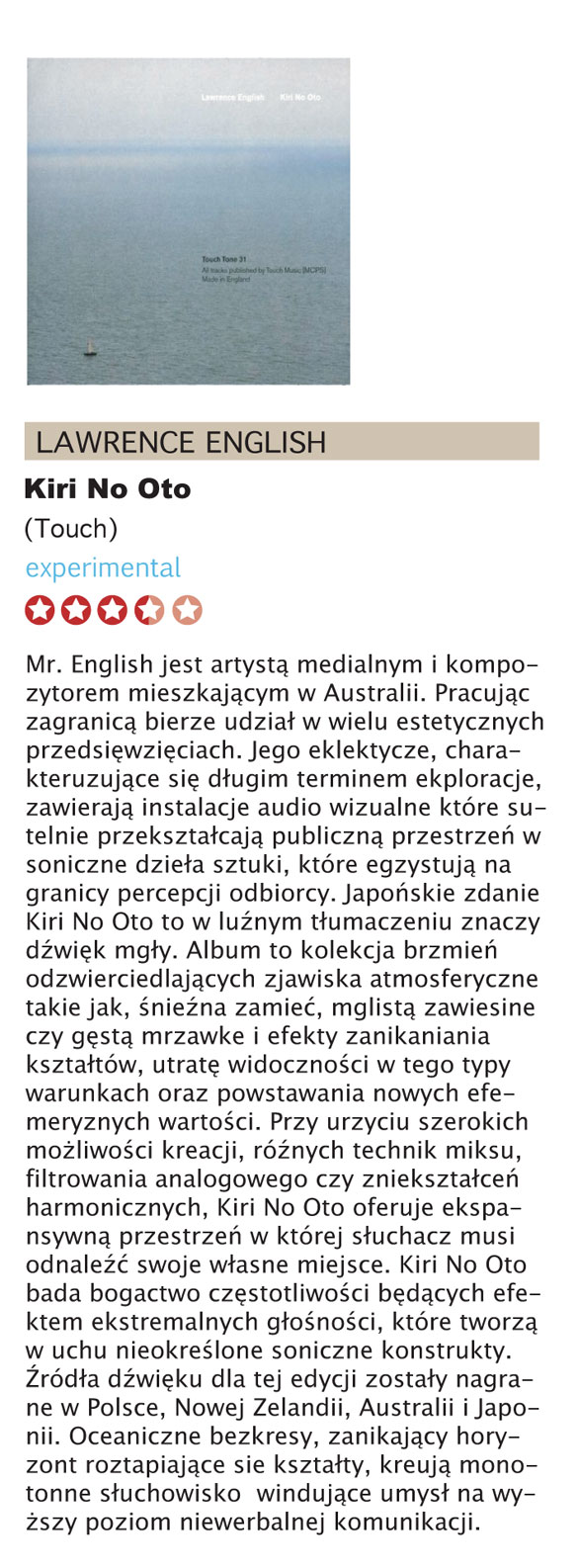
MOJO (UK):
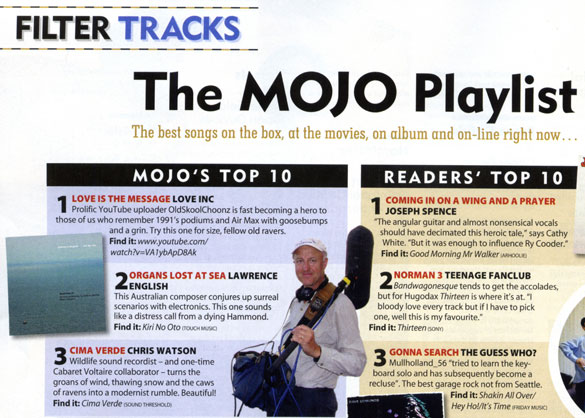
Signal To Noise (UK):
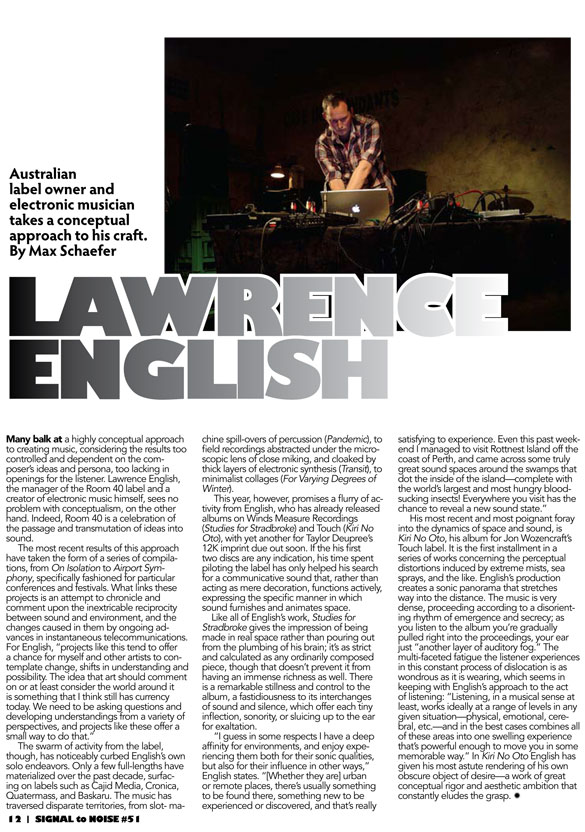
SPEX (DE):
Geräuschmusik
mit Lawrence English, Daniel Burke & Thomas Dimuzio, Greg Davis & Sébastien Roux und Black To Comm
Text: Kai Ginkel
Befindlichkeiten lässt Lawrence English allesamt beiseite, in seiner Musik sowie der grafischen Gestaltung des Album-Artworks klingt genuine Geräuschmusik. Außerdem in der neuesten Ausgabe dieser Kolumne: Dan Burke und Thomas Dimuzio wirken ungeheuer befremdlich wirken, Greg Davis spielt immer wieder mit längeren Stilleperioden und die Musik von Black To Comm ist auf eine subtile Weise einigermaßen ätzend.
Lawrence English, Gründer des hervorragenden Labels room40, war zuletzt für das Mastering von Maurizio Bianchis »Regolelettroniche« verantwortlich, ein Album, das besonders klanglich ein regelrechtes Meisterstück ist. Mit »Kiri No Oto« (Touch Music) greift English selbst nun ähnliche Motive wie sein italienischer Kollege auf, bleibt dabei aber inhaltlich noch weit diffuser und weniger konkret als Bianchi, dem zumindest eine »spirituelle« Komponente zuweilen anzumerken ist.
English dagegen lässt, wie es scheint, die Befindlichkeiten gleich allesamt beiseite und realisiert mit dem vorliegenden Album das Optimum dessen, was gute Geräuschmusik leisten kann: die Klänge zu finden, wo nicht nur die Worte, sondern auch andere Möglichkeiten zur konventionellen Mitteilung fehlen. Seine schwelgerische, sehr individuell realisierte Geräuschmusik ist geprägt von einem Sinn für das Schöne, der in einer offenbar vollkommen kitschfreien Gedankenwelt existiert. Immer wieder haben diese Stücke etwas Dröhnendes, oberflächlich fast Stumpfes an sich, das niemals über die Maßen geglättet wurde. Ein Musterbeispiel für diese Kunst ist der Opener »Organs Lost At Sea«, der mit Sicherheit zu den ergreifendsten Drone-Stücken der vergangenen Jahre gehört.
Das Konzept von Touch Music, für jedes ihrer Realeases ein vollkommen menschenfreies Artwork zu verwenden, das meist eine karge, schön fotografierte Landschaft zeigt, hat mit den Jahren interessanterweise nur gelegentlich an Reiz verloren: Was auf den ersten Blick verwandt erscheinen kann mit der hübschen, zuweilen aber auch inhaltsleeren bis kitschigen Bebilderung, die jeden neuen Tonträger aus dem Hause des bekannten Münchener Jazz- und Klassiklabels ECM begleitet, entfaltet im Zusammenhang mit der typischen Touch-Musik (die es bei aller Vielfalt durchaus gibt) eine ganz eigenwillige Stimmung, die vor allen Dingen Folgendes unterstreicht: Ebenso, wie für das Artwork kein Mensch, weder Künstler noch Statist, fotografiert wurde, ist auch der sonstige Inhalt so wenig wie möglich von Eitelkeit und Ego-Prahlerei belastet. Gerade »Kiri No Oto« ist ein Musterbeispiel für die reine Konzentration auf Klang und Atmosphäre. Selten, kann man schlussendlich sagen, wurde eines der typischen Jon-Wozencroft-Artworks so treffend vertont wie hier: Gerade durch den angesprochenen schroffen Charakter der Musik erhält man den Eindruck, dass eine künstlerische Vision praktisch vollkommen sich selbst überlassen wurde.
Losing Today (Italy):
‘Kiri no oto’ in giapponese vuol dire “suono della nebbia”. Un titolo emblematico che descrivere benissimo il contenuto del nuovo lavoro di Lawrence English. Il proprietario della piccola ma incontenibile Room40 ha raccolto i suoni dell’acqua, e soprattutto dei suoi vapori, durante viaggi in Polonia, Nuova Zelanda, Australia e Giappone per poi lavorarli con mille filtri incredibili nel suo studio di XXX. La prima delle otto tracce in scaletta, “Organs Lost At Sea”, comincia con un drone dissonante ‘instabile’, in continuo movimento. Subito dopo “Soft Fuse” rallenta l’incedere e anche l’atmosfera diventa quasi impalpabile. “White Spray” indugia ancora sul lato piu’ rumoroso dell’arte di English mentre una calma inquieta avvolge la sorprendente “Waves Sheer Light”. Quindi appare il baratro sul nulla descritto magistralmente nei quattro minuti e trenta secondi di “Commentary” prima dell’estasi abbagliante di “Alley” e del crescendo maestoso di “Figure’s Lone Static’. [Roberto Mandolini]
The Wire (UK):
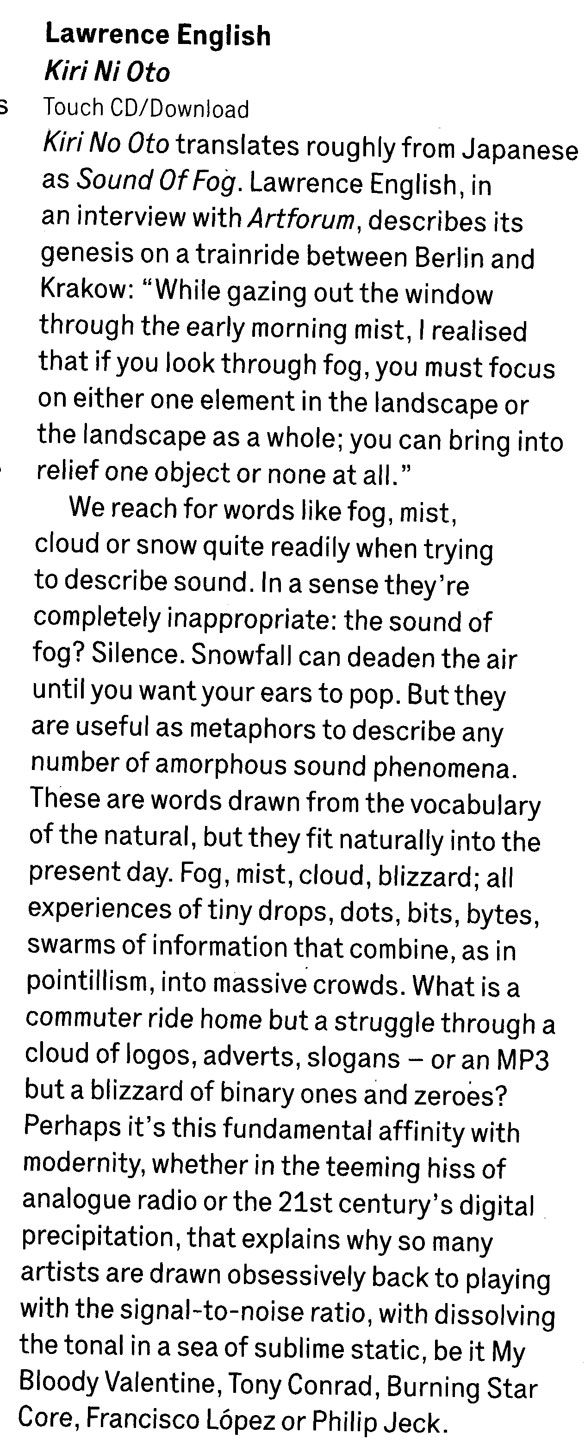
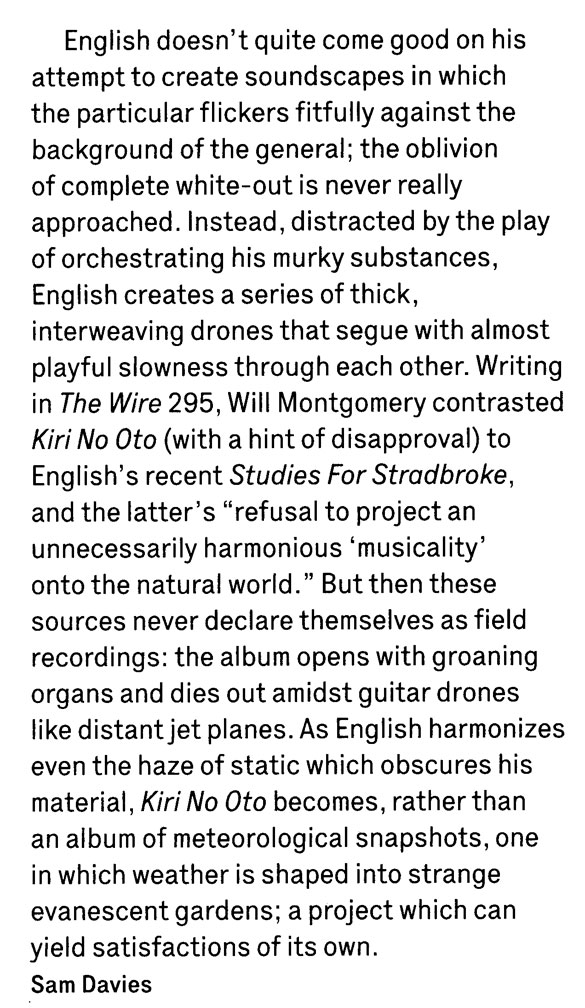
D-Side (France):
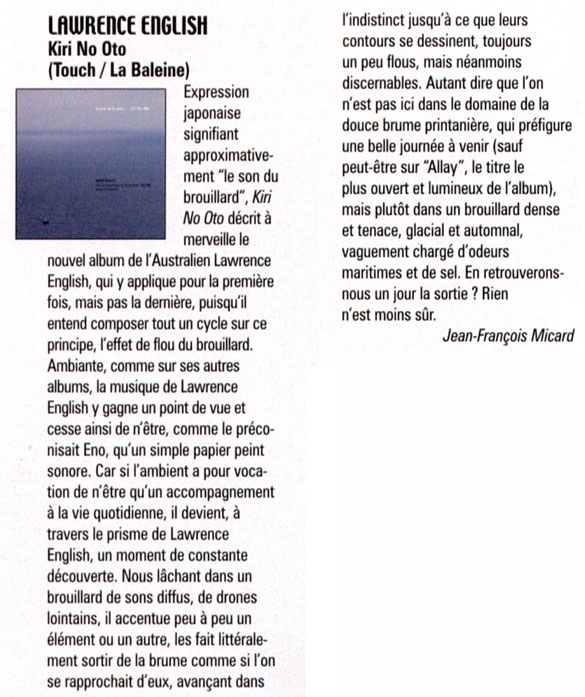
XLR8R (USA):
With Kiri No Oto Room40 label boss Lawrence English presents his densest ambient work to date. The somewhat stately micro-sound strains of his previous work have been infused with howling distortion, organ-based melodic washes, and a thick gauzy haze. Roughly translated from Japanese, the title Kiri No Oto (“sound of fog”) fits the album perfectly. At times it’s tastefully reminiscent of Popul Vuh, while coating your brain like Tim Hecker’s ambient-metal epics. Kiri No Oto is wonderfully immersive, and as the album unfolds, English’s grip tightens, pulling you deeper into the fog. A great piece of subconscious architecture. [Tim Saputo]
allmusic (USA):
What a wonderful idea the Touch label had to add Australian soundsmith Lawrence English to its fold. The man has belonged on that label almost since his beginnings, but even moreso with the gorgeous Kiri No Oto. The title is Japanese for “sound of fog” or “sound of mist,” an apt description of the music herein. Slightly warmer than English’s previous album For Varying Degrees of Winter, Kiri No Oto focuses on soft blankets of filtered sounds (organ, guitar, found sounds), delicately overlaid and panned in and out of focus. The 45-minute album unfolds like a single extended piece, each movement bringing in different hues. The opening “Organs Lost At Sea” jumps straight to the point, engulfing the listener in its harsh-yet-harmless textures. Things boil down suddenly with “Soft Fuse,” then gradually climb back toward a climax in the penultimate piece, “Figure’s Lone Static.” That track ends quietly, luring us into the even more climactic climax (and abrupt landing) of “Oamura.” Kiri No Oto marks a new page for English, whose sound used to be less expansive and slightly closer to the “glitch” ethos. Here, he dives straight into ambient noise music, more Fennesz than Thomas Koner, and it works. This album, presented as the first installment in a series of like-minded records, is not particularly innovative, but whereas others dabble and try, English executes – with sensitivity and artistic flair. Highly recommended.
Touching Extremes (Italy):
There’s a strange sensation in me after having spun “Kiri No Oto” for the third successive time and been somehow unable of breaking the cocoon of its buried secrets. If those secrets do exist, they’re barely discernible in the bulky amassing of mainly distorted frequencies characterizing the music. At the end, this writer even speculates about the original plan as being exactly that: no actual access to the quintessence of the sonic matter. The album title – something like “the sound of fog” from Japanese – also seems to be revelatory in that sense, which is in effect a contradiction in terms. The eight tracks are seamed uninterruptedly, as in a single piece; the sources include both normal instruments (definitely guitars, one would say) and field recordings captured in Poland, New Zealand, Australia and Japan. There are, in truth, a couple of dramatically stunning moments, the transition from “Organs lost at sea” to “Soft fuse” a personal favourite; breathtaking stuff indeed. The rest is predominantly spinning around that sort of harmonically cuddling saturated dispersion that could be, perchance, pretty warmly welcomed by fans of Birchville Cat Motel (minus the aggressiveness: the majority of the substance here tends in any case to rippled stasis, vu-meters on red or not). The choice of bathing the compositions in such a pool of corrosive liquids translates into a total incompatibility (at least for my taste) with headphone listening. Jury still out, but English’s earnestness is not debatable. [Massimo Ricci]
Orkus (Germany):
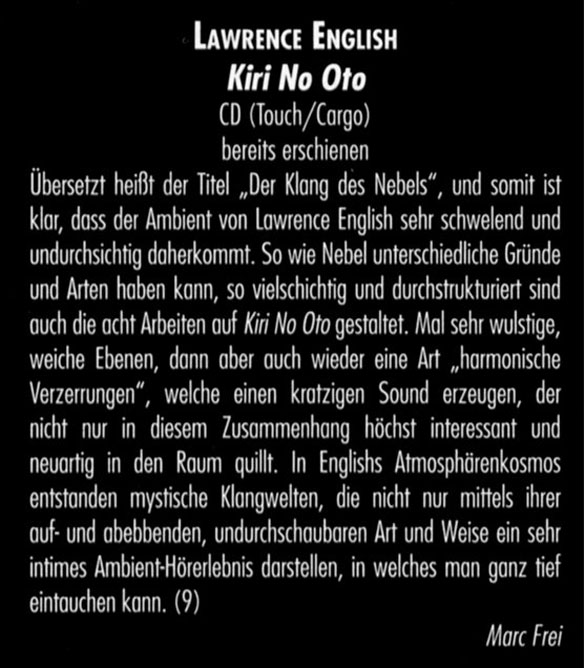
goutemesdisques (France):
Expert en musiques polaires, Lawrence English sonde une fois de plus les abysses. Pour être plus précis, il plonge en plein brouillard. En effet, le titre du disque ne veut rien dire d’autre que «le son de la brume». Disque de dark ambient aux intonations noise, Kiri No Oto a été enregistré, comme bon nombre de ses prédécesseurs, aux quatre coins du monde. Pour autant, quel que fut l’endroit où les morceaux furent conçus, Lawrence English s’est attaché à leur donner la même consistance. Kiri No Oto est plein de mystères et on avance avec lui avec une prudence quasi sereine. Disque apologétique de la lenteur et des ambiances monolithiques, l’environnement sonore utilisé ici ne nous est pas étranger. On remarque simplement que Lawrence English fait se rencontrer une ambient sortie des profondeurs et l’âpreté d’une musique industrielle aussi retorse que dénuée de toute chaleur. C’est comme si l’immensité de l’océan intégrait le plus naturellement du monde une force mécanique puissante mais qui avancerait avec une vitesse minimale et déterminée. On peut s’imaginer un brise-glace pénétrant irrésistiblement les étendues arctiques au beau milieu d’un fog épais qui ne dévoilerait absolument rien.
L’avantage avec Lawrence English est bien là. Sa musique est tellement évocatrice qu’on peut laisser libre cours à notre imagination lorsqu’on l’écoute. Cette sobriété alliée à une occupation totale de l’espace lui permet une certaine souplesse. Une souplesse qu’il faut pourtant bien expliquer. En effet, il aurait été tellement plus simple pour English de se borner à des nappes froides qu’il aurait pu moduler selon son bon vouloir. Lui, il alterne entre sérénité vaporeuse et séquences de bruitisme maîtrisées qui donnent ce côté si inquiétant et angoissant. En soi, on ne fera pas de grandes découvertes ici mais là n’est pas l’essentiel. Tout l’intérêt de Kiri No Oto passe par les émotions qu’il nous apporte, par sa profondeur et sa sombre exploration d’environnements hostiles. En cela, Lawrence English est tout à fait fascinant. Poursuivant la même logique que sur ses efforts précédents (on se souvient de Happiness Will Befall et de For Varying Degrees Of Winter), l’Australien se pose comme un maître du genre avec la consécration de voir son travail publié sur le label le plus exigeant et le plus reconnu qui soit: Touch.
Octopus (France):
Si Lawrence English est australien, la consonance de son nom a peut-être un rapport avec son attirance conceptuelle pour les formes musicales éthérées et gazeuses, les moments d’expectation choisies et de plénitude sonore intense, plus en rapport avec les images d’Epinal des bords de la Tamise qu’avec la réalité quotidienne d’un musicien basé à Brisbane, capitale de la Golden Coast wallabie. L’évidence est même de mise lorsqu’on écoute ce somptueux Kiri No Oto, expression japonaise pouvant être traduite par le son de la brume ou du brouillard. L’univers qu’y dévoile Lawrence English est d’une profondeur granuleuse à découper au couteau. Un océan ambient de moiteur flétrie, mais étonnamment confortable et disert, dans lequel on se laisse bercer et à peine bouleverser par les quelques brisures placées en écho, comme lorsque la soufflerie virtuelle qui sert de fil conducteur à l’album s’emballe par à-coups (sur “White spray” par exemple).
Lawrence English façonne littéralement sa musique, usant de jeux de filtres et de couches additionnelles pour épaissir à l’envi ce fog sonique qui se glisse en filigrane de l’écoute, travaillant également ses harmonies nuancées et flottantes à travers de subtiles distorsions, miroirs de perspectives auditives magnifiées, comme sur ce “Waves sheer light” confusionnel, partagé entre torpeur et grincements [Laurent Catala]
Le Temps (Switzerland):
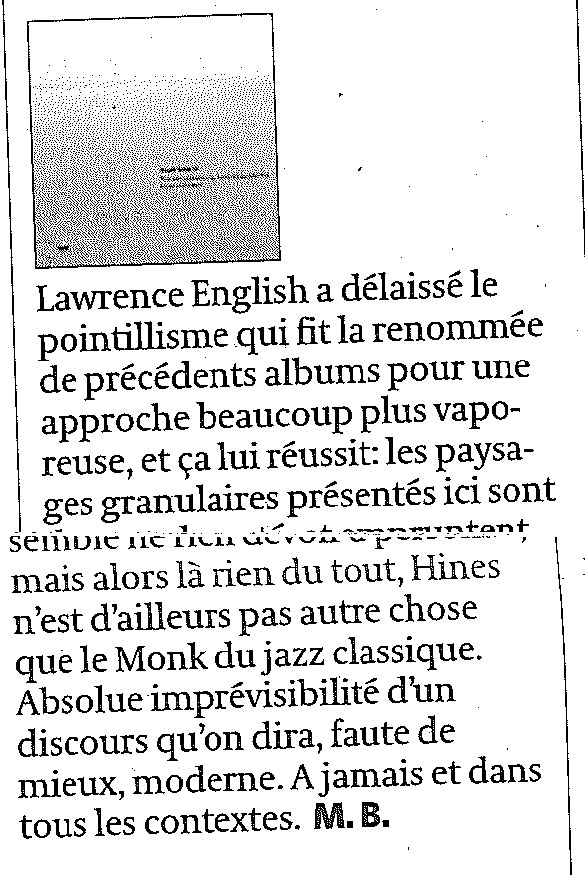
Rockerilla (Italy):
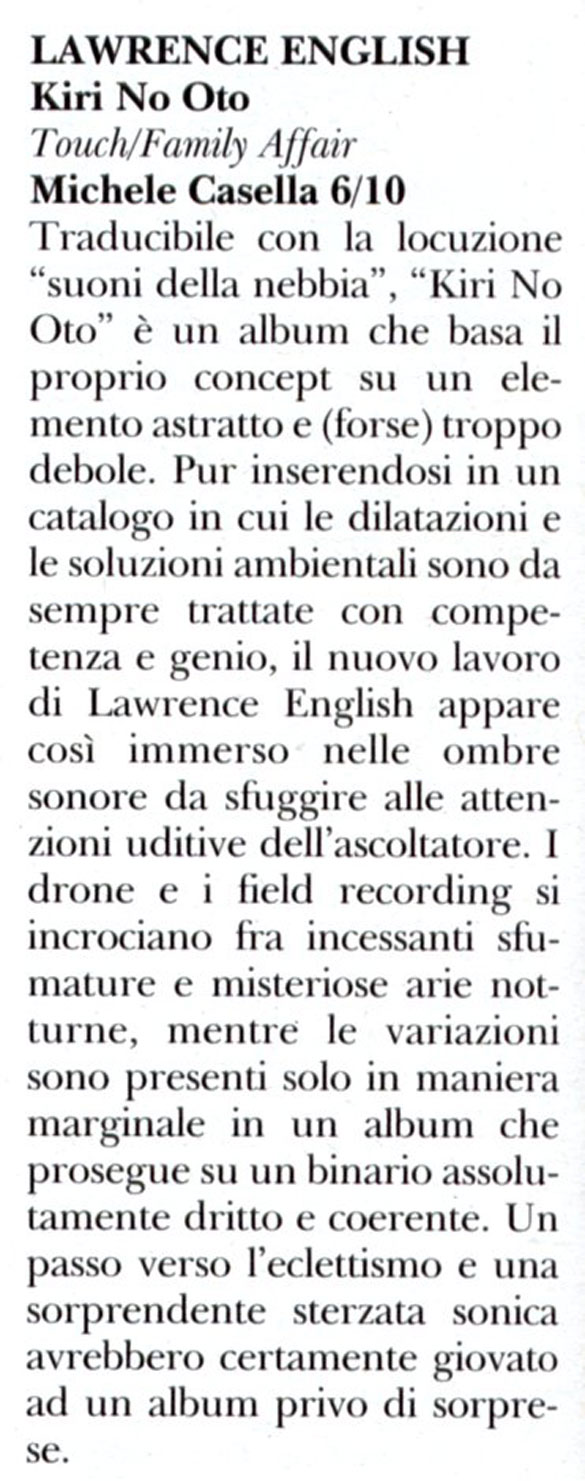
plan b (UK):
Australia’s Lawrence English has chosen his album’s title well – the Japanese phrase ‘kiri no oto’ translates as ‘sound of fog’. This music shifts around like am amorphous armada of hygroscopic particles. Maybe John Carpenter’s gruesome Eighties horror flick, The Fog, was an inspiration; just as the film’s ghostly crew emerges from the luminescence to wreak its revenge on the populace of Antonio Bay, so, from out of the dense and seething mists of English’s analogue harmonics and processed field recordings, do his previously concealed elements come to light. English has done as Matisse once directed: “Derive happiness in oneself from a good day’s work, from illuminating the fog that surrounds us.” He’s done himself proud. [Spencer Grady]
Sound of Music (Sweden):
Australiensaren Lawrence English debut på Touch smälter in i det engelska bolagets utgivning som hand i handske. Utdragna sekvenser projiceras i ljudrummet, vilka man lätt och gärna förirrar sig i. Till musiken finns ett avstånd, som lyssnare placeras man som på en höjd med vidunderlig överblick – tror man. Istället förflyttar sig fokus snabbt mellan olika ögonblick, dock inte rastlöst och okoncentrerat utan nyfiket och förnöjt. Storslaget är ett ord som snabbt dyker upp när jag för mig själv söker efter passande beskrivningar för skivans åtta låtar.
“Kiri No Oto” betyder träffande “ljud av dimma”. Instrument och “hittade ljud” (found sounds) förvrängs och filtreras till oigenkännlighet. English själv talar om “‘harmonic’ distortion”, och han “utforskar rikedomen hos frekvenser som vanligtvis associeras till extrema volymnivåer” för att skapa ytterligare nivåer av ljudlig dimma. Det innebär inte att musiken i sig behöver spelas extremt högt, snarare får de djupa frekvenserna just den effekten han önskar, då de skapar en känsla av att nästan svälja övriga ljud och på så sätt göra ljudbilden än mer svårfångad och höljd i dimma.
English bygger vidare på den dronande traditionen som i grunden hämtar mer inspiration från ett österländskt musiktänkande än ett västerländskt. Ackordföljder och tonalitet är ganska ointressanta i sammanhanget – han gräver istället djupt i de funna ljuden och är inte rädd för att låta enformig. Han gestaltar ögonblick och gör dem viktiga, om än flyktiga. [Magnus Nygren]
foxydigitalis (USA):
Two summers ago I went on this family vacation to Washington Island, Wisconsin. The Island is probably about a hundred or so square miles, and is just of the peninsula of Door County. To get to the Island you have to take a car Ferry, and the whole trip lasts about 20 minutes or so. I’ve never been on too many boats for one reason or another. Maybe a couple of ferries here and there to Mackinac Island from northern Michigan but I don’t remember those. I’ve been on speed boats in small lakes and rivers, as well, and the largest body I’ve ever spent a considerable time near is still Lake Michigan (which, for all intents and purposes is big enough). On the Ferry to Washington Island, if you looked east into Lake Michigan’s expanse, you saw nothing but horrifying horizon. There was a tiny Island with dead trees and an old house (which I was convinced was awesome and could not find on any map or again relocate from satellite). I became transfixed by the water, the way in choppy conditions in churned, rocked the boat, seemed bubble pyramidal waves that went wherever they wanted in the crosswinds. Later that summer I would take a kayak out into the lake (I’d never done it before) during stormy waves, Their movements were improvised and determined to catch me unsuspecting. It was unfathomably beautiful. The last time I had been so mesmerized by water was when I went out at sunset into a sandbar in lake Michigan and saw nothing but water to the limits of my periphery. I felt meaningless and the weight of existence was like a drug-state. I felt I was approaching some asymptote of knowledge and experience that was as freeing as it was frightening. I was sixteen. Melville was right about the bodies of water. There is something nigh on heavenly about it, it brings out untold things in us. Something does draw us to it. I was obsessed for a period of time with Isis’s “Oceanic”, a whole progressive metal album dedicated, in the abstract, to the sea. Isis makes very linear, methodical music though, and the sea moves with near reckless abandoned though very brilliantly organized at a chemical level. As much I still do enjoy “Oceanic”, it can only represent in the abstract the power of its muse.
Lawrence English’s Kiri No Oto (translation: sound of fog ) is something of a minor masterpiece. Were it not for a slight feeling that it lacks a particular core sustain, I am fairly convinced this record could mentally destroy me. Though the Brisbane -ased composer has constructed something that “meditates on the sense of displacement and distortion that occurs in environments which undergo extreme mists, snowstorms and sea sprays,” there is also this oceanic sense to the music. On a Ferry during an overcast, I found myself fumbling through my music library looking for something appropriate for the occasion. Something brooding, menacing, reverent, immediate and visceral. Something wrapped thickly in a blanket of sounds, something without edges that was crushing and drool-inducing. I did not have this album at the time, so who knows what I chose.
Kiri No Oto begins by dropping cubic tons of fog on you with “Organs Lost At Sea”, an instant burst of harsh distortion at varying frequencies, pitches, and filtration that weighs on the brain and yes, sound like faint organs. It also sounds like the fucking sea speaking to you. I don’t know why music conjures up some sort of personification of landscapes but on “Kiri No Oto” English does it to the degree that I’m convinced he hears something in these environments that angels or spirit creatures probably hear, the resonant hum that the ancients thought kept the universe from collapsing on itself. Though he uses both found sound (from New Zealand, Australia, Japan, and Poland no less) and instruments. There is no separating one from the other. Whatever he is using is being pushed to the amplitudinal limit and I suppose, the way I was listening to it, is dangerous to the ears. But more importantly, if we adopt say, the tired rhetoric that all drugs are morally bad, then this is aural crystal meth. After the rush of “Organs Lost At sea” The rest of the album is just way too hard to describe. Sheets of tones move in and out and run the complete gamut of your range of hearing. A high ring undercut by a chest-rattling rumble. It is all very soft and gradual, noise but not in the way ‘noise music’ is noise. Though there are granular, abrasive moments, they don’t come as a surprise. The point again, is that “Kiri No Oto” is “an expansive sound space in which the listener must choose to position themselves. Focus, like that in a fog, is in a constant state of flux, as elements are brought into and out of perspective.” I suppose one knows they’ve done well when their press release sums up the experience better than you can. There is one instance where I feel like I am walking by either a ship’s engine or the soul of a Blue Whale or both combined into some android whale-ship. The last track, “Oamura”, cascades into a tidal movement, eventually sounding like massive waves of ball bearings crashing impossibly on the shore, and then you are engulfed by it, and then the whole thing cuts out as abruptly as it hit you. After several listens I still don’t really know what’s going on in-between save for my own blissful semi-consciousness.
There is ambient, droning, lilting music and then there is full scale immersion. I put on Stars of the Lid on when I study, and whenever I meet people whole like the Texas duo they admit as much as well. Sometimes they stop me in my tracks but mostly they clear the brain. Lawrence English puts me into another noise coma. I guess I go into a lot of those, but when I do I’m not picturing limitless expanses of churning, unpredictable waves, or recalling the 20 hour road trip from Boston to Saint Louis where I encountered a two hour expanse of oscillating heavy fog that made me feel I had driven right through the limit of the waking world. “Kiri No Oto” is the first in a series dedicated to exploring similar sonic themes. I suppose saying that I am looking forward to what is next is an understatement. 10/10 [John Ganiard]
Musique Machine (UK):
Lawrence English is known as an ambient sound artist as well as the proprietor of the Room40 label. Kiri No Oto translates roughly from Japanese to English as “sound of fog”, which is absolutely an appropriate title for this release. It starts off with Organs Lost at Sea, a brilliant, relatively intense drone piece. The organ tones sound stacked atop each other, in the Phill Niblock vein, and they’re either distorted in post-production, or just mixed so far into the red that a blurry effect is attained. The next track, Soft Fuse is a mellow ambient piece, which includes little micro-tonal elements if listened to closely. White Spray starts off, again, in an ambient vein, but at about a minute and a half in, it becomes a dense and noisy, shifting soundscape. It’s an abstract piece which generates tension, pulling you forward, much like an undertow into the next track. Waves Sheer Light is the sound below the waves. These sounds come at you from every direction, with hidden melodies and speaker-phasing ambience undulating in seemingly limitless combinations. And so it goes. What’s truly fascinating about this album is the atmosphere that English generates. It’s a rare instance of a concept album which draws you into an audio representation so convincingly. It’s difficult not to picture the cascading surf, rough seas or all enveloping fog when listening to Kiri No Oto. What’s most intriguing is the fact that none of these pieces are in any way unadorned field recordings. English uses the abstract means of an artist to achieve the end result.
The sleeve tells us that this album was funded by the Australian government, through the Australia Council for the Arts. You might think that it would be dry, high minded, perhaps even conservative as a result. But that’s not the case at all. In fact, Kiri No Oto is not only artful, it’s downright entertaining. And It sounds amazing. The production is top notch, and it’s engineered to provide a different experience every time you listen to it, depending on your location in the room. Headphone listening is fine, but Kiri No Oto is best heard through loudspeakers at a generous volume. Heartily recommended. [Roger Batty]
EARLabs (Netherlands):
This cd at first hearing brings home the usual blend of drone music and so at first I was not very impressed by it. Listening to it with a headphone, however, changed everything.
The cd is packaged in the usual quality cover that we know from Touch. Quite familiar but oh so very delicate. Touch has always given great care to nice and special packaging and especially the photography is wonderful. This is no exception. As I said in my introduction this at first sounds like your ordinary drone stuff. But when I listened to the cd again, weeks later, with headphones I was sold. Yes, it is droney but English focuses a lot on the details and that’s where it counts of course when we’re dealing with droney material. Because the sublayer is like a greyish hue, slowly shifting and blending in and out the listener starts focusing on texture. A ripple, a slight cut is what gets immediate attention.
English is not afraid of distortion. In fact he makes use of the rough edges that a saturated sound recording yields. Unfortunately here too the cancer of extensive reverberation has spread, which is especially boring in track 4, “Wave Sheer Light” where looped flute sounds are reverberated. I guess in order to straighten out the loopiness.
Best track is definitely number 2: “Soft Fuse” which delivers that slight crackliness over a very tender blanket. [Jos Smolders]
Igloo Magazine
“…Kiri No Oto – the ‘sound of mist’ – takes this inquiry into the territory of cognitive disorientation, seeking to provide an audio-documentation of the experience of obscured environments, adding whole new resonances to that favourite epithet of reviewers for describing experimental ambient-electronica, ‘foggy’…”
“If you look through fog, you must focus on either one element in the landscape or the landscape as a whole; similarly when confronted with indeterminate auditory data, the listener may seek to absorb the sound mass or resolve to focus so as to better connect with a particular frequency spectrum or texture.” Thus conceptualises Lawrence English, who has for some time now been exploring various themes at the multi-modal interface between audio-visual environments and interactions of found sound-vision elements. And Kiri No Oto – the ‘sound of mist’ – takes this inquiry into the territory of cognitive disorientation, seeking to provide an audio-documentation of the experience of obscured environments, adding whole new resonances to that favourite epithet of reviewers for describing experimental ambient-electronica, ‘foggy’.
Deploying a variety of state-altering strategies such as filtering and harmonic distortion techniques, English here draws out a series of expanses which are populated by ambiguously resolved textures, designed to interestingly problematise listening focus. A state of micro-flux and mutability prevails, as elements seem to float into a perspective which either becomes illusory or seems to shift to require re-focus. Instrumental sounds sources commingle with found sound from location recordings to throw up dense flows of now disintegrating now coalescing soundmass, interspersed with oddly-lit apertures, oscillating between uneasy rests and natural hazard-like flurries.
“Organs Lost at Sea” opens in thick church-organ drone edged with a doom-y gruzz, before calming into the more vaporous, but still granular “Soft Fuse.” The tenor of these opening pieces nods to the likes of Aidan Baker and Tim Hecker while retaining a distinct voice. The yawning chasm which then opens onto “White Spray” is irrupted into by a harsh vortex of noise at whose tonal centre is whirled a miasma of barely apperceptible tonalities; a sensory overload that then segues into the shimmer and fade resonances emanating from “Waves Sheer Light,” whose squalling spindles of sound ripple out with an aspect of both presence and spectrality, over-exposed figures seen through a smeared glassine mist. Here the spirit of fellow-Toucher and environmental experimentalist BJ Nilsen is glimpsed. “Commentary” continues the ethnography of melodious murk, twisted harmonic treasures needing to be dug for in a bed of audio-muck. The neo-Kosmische tones of “Allay” conjurs up ghosts of Popol Vuh (along with Biosphere shades), widening the soundstage with some more tangible elektronische matter. “Figure’s Lone Static” stands out in that, unlike other pieces fixating on concept at the expense of aesthetic, it fuses a concern for genuine musical beauty in its composition with effective rendering of the mission statement; it shifts from soft pastel shades into immersive swells and billows infused with a hail of grit, unfolding into an eroded grandeur of stretched organ swathes. Closing piece “Oamura” starts out in Martin Rev-like primeval organ drones, progressively ramping up into a steepling fuzz, slowly pulled this way and that into a low keening of tidal lurches, before being eaten away by a thickening fog of static and noise, disappearing into nothing, as the plug is wrenched out and all is erased.
In sum, English’s assemblages are effective in achieving their projected concept, setting delicate pointillist tonalities against a rougher fabric of tweaked overtones and evanescent harmonics. Moments of clarity come wrapped up in clouds of confusion, while apparent obscurity is shot through with lucid flashes of errant colour and tricky texture. One to navigate with caution, certainly, but English’s soundings are ultimately engrossing, and the sound of this mist is not to be missed. [Alan Lockett]
Stereo & Video [Russia]:
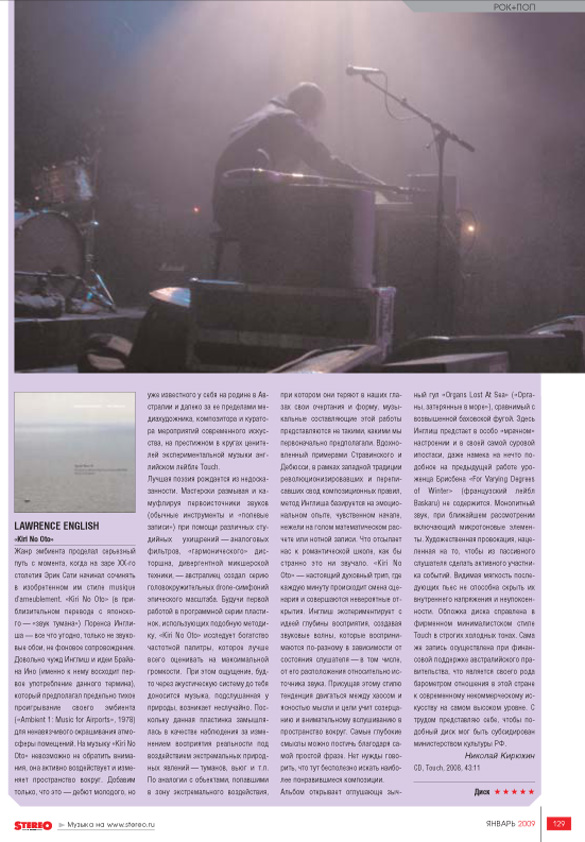
Musique Magazine
Album of the Month. Lawrence English is known as an ambient sound artist as well as the proprietor of the Room40 label. Kiri No Oto translates roughly from Japanese to English as “sound of fog”, which is absolutely an appropriate title for this release. It starts off with Organs Lost at Sea, a brilliant, relatively intense drone piece. The organ tones sound stacked atop each other, in the Phill Niblock vein, and they’re either distorted in post-production, or just mixed so far into the red that a blurry effect is attained. The next track, Soft Fuse is a mellow ambient piece, which includes little micro-tonal elements if listened to closely. White Spray starts off, again, in an ambient vein, but at about a minute and a half in, it becomes a dense and noisy, shifting soundscape. It’s an abstract piece which generates tension, pulling you forward, much like an undertow into the next track. Waves Sheer Light is the sound below the waves. These sounds come at you from every direction, with hidden melodies and speaker-phasing ambience undulating in seemingly limitless combinations. And so it goes.
What’s truly fascinating about this album is the atmosphere that English generates. It’s a rare instance of a concept album which draws you into an audio representation so convincingly. It’s difficult not to picture the cascading surf, rough seas or all enveloping fog when listening to Kiri No Oto. What’s most intriguing is the fact that none of these pieces are in any way unadorned field recordings. English uses the abstract means of an artist to achieve the end result.
The sleeve tells us that this album was funded by the Australian government, through the Australia Council for the Arts. You might think that it would be dry, high minded, perhaps even conservative as a result. But that’s not the case at all. In fact, Kiri No Oto is not only artful, it’s downright entertaining. And It sounds amazing. The production is top notch, and it’s engineered to provide a different experience every time you listen to it, depending on your location in the room. Headphone listening is fine, but Kiri No Oto is best heard through loudspeakers at a generous volume. Heartily recommended. [Erwin Michelfelder]
Ox Fanzine [Germany]:
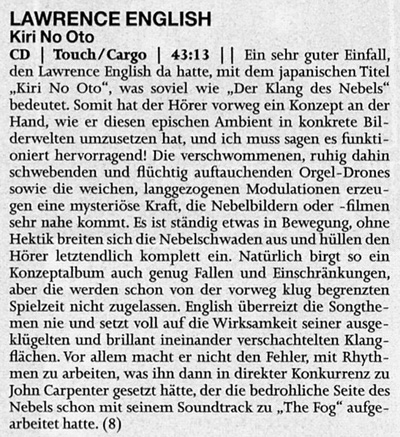
Tokafi:
The only safety lies in concentrating on yourself: Forces listeners to avoid settling in too much.
There are several good reasons why “Kiri No Oto” should be perceived and appreciated as programmatic music. With a cover image depicting a solitary catboat steering towards the promising horizon of the ocean’s infinite greyness, track titles like “Organs Lost At Sea”, “White Spray”, “Waves Sheer Light” and “Oamura” (a lovely coastal town on New Zealand’s South Island) as well as a closing sequence of a passionate tide coming in on the listener, it is more than apparent that Lawrence English has set his sails for the sea.
This is not exactly a revelation: English’s personal biography has previously revealed a deep personal affinity for the mysterious pull of vast water-planes. As the inhabitant of an island in general and a former resident of Wellington in particular, the ocean was never far off and the secrets of its enigmatic pull undeniably forced itself upon him more insistently than any old longshore lubber could ever understand. As head of the Room40 imprint, he also authored a solemn and heartfelt press release to Chris Abrahams’ and Mike Cooper’s hauntingly ephemeral “Oceanic Feeling”, which spoke about “island-like compositions”, a “divergent sound archipelago” and “a picturesque horizon of melodic ocean swell” – in his heart of hearts, this man is a nautical romantic.
It is all the more remarkable, then, that neither “Oceanic Feeling” nor “Kiri No Oto” have succumbed to the temptation of depicting their subject matter in the all too familarly soft light of sweetly scented cliches: The anthemic rusty foghorn drones that crush through the floodgates of the album’s opening seconds are testimony to the sea’s brutal primeval powers and in its uncomfortable finale, humming bass clusters are rubbing against each other in a violent display of uncompromising undertones. The Pacific (nor the Tasman, nor any other sea for that matter) is no dreamy, constant, evenly liquid surface – it is a ceaslessly morphing scape, capable both of lulling you to sleep with silent whispers and of roaring like a mad and infuriated beast.
English is particularly interested in the characteristics of mist and spray and the challenging situations they force upon the human physique and mind: What happens, when our perceptional horizon shrinks to a radius of a few metres? How do we cope with the growing share of unpredictability, uncertainty and fuzziness that permeates our world? And, most importantly: In an environment which defies clear-cut centres, can we still see ourselves as individuals and rely on the consolation of the Descartian “Cogito Ergo Sum”? These – at least metaphorically and without the slightest whiff of philosophical pretence – are the kind of questions that he sets out dealing with.
Entire labels have built their catalogue on these reflections and just as much as clarity is a Leitmotif of the drone genre, so is opaqueness. The mere fact alone that these tracks are built from various, intertwined harmonic layers, whose positional shifts against each other create flurry fields of oscillation rather than monotonous tonal stability is therefore hardly worth mentioning. Nor, necessarily, is the concept of using quiet feedback and silenced distortion, usually the products of extreme levels of volume, as a timbral tool.
What is, however, is the ambition of taking this concept to the length of an entire album while simultaneously forcing himself to get to the point quickly. Every single piece on “Kiri No Oto” could easily have been rolled out into a blissfull ambient epic. Instead, English ends the budding ethereal vision of “Soft Fuse” after a mere six minutes, takes the delirious cavernous reverberations of “Commentary” to an early (but not premature) resolution and floods the droning two-tone pattern of “Oamura” with gushing field recordings at the three and a half minute mark.
It is therefore individual compositions themselves which are starting to move against each other, not just their constituent musical building blocks. It is here, too, that the record attains a layer of meaning that goes far beyond its initial concept. English doesn’t seemlessly segue his pieces, but allows them to breathe into each other, with the first note of a new track picking up the pieces where its predecessor has left them. Contrasts between movements are therefore high by default already and yet he amplifies the effect even more by placing rough works next to smooth ones and juxtaposing serene and silent emanations with forceful sonic gail-storms. The approach forces listeners to avoid settling in too much, to stay alert and watch their back.
Instead of a peaceful flow, someting completely different emerges from this rhythm of contrasts: Absolute stillness. In a world where there don’t seem be any centres and certainties, the only safety lies in concentrating on ourselves and our sensory perception of what surrounds us. If you follow English down all the way into the hypnotic ramifications of his idea, all elements will suddenly start to make sense on a purely intuitive level. There is no such thing as chaos, English appears to suggest, if you choose the right angle. It is a deeply satisfying and consoling thought and you don’t even need to listen to “Kiri No Oto” as programmatic music to arrive at this conclusion. [Tobias Fischer]
soundproector.com (Russia):
Those who constantly observe the scene of experimental ambient music can always be aware of innovations in the creative work of Australian media artist Lawrence English. In his works Lawrence often uses his own field records together with modern technologies of sound arrangement. In his last album released in July 2008 on label Touch English he represents his so-called ‘foggy sound’ (that’s the approximate translation of the album’s title from Japanese). We don’t know where these field records, used as raw materials for each track of Kiri No Oto, come from. His music is nothing else but sound masses smeared over the walls, ceiling and all things round us. Music with low frequency, without distinct structure and streight development, without obvious corners and borders, no starts and endings…
We are taken away to the zone of high haziness by the rumble dense so much that it seems to fill up everything around, no ray of sun coming through it. Or maybe we are at the bottom of an ocean depicted on the compact disc’s cover, we watch its calm and relaxed life from inside. In any case we may say for sure that the experiment with ‘foggy’ and ‘raw’ sound was successful.
Liability (France):
Expert en musiques polaires, Lawrence English sonde une fois de plus les abysses. Pour être plus précis, il plonge en plein brouillard. En effet, le titre du disque ne veut rien dire d’autre que «le son de la brume». Disque de dark ambient aux intonations noises, Kiri No Oto a été enregistré, comme bon nombre de ses prédécesseurs, aux quatre coins du monde. Pour autant quel que fut l’endroit où les morceaux furent conçus, Lawrence English s’est attaché à leur donner la même consistance. Kiri No Oto est plein de mystères et on avance avec lui avec une prudence quasi sereine. Disque apologitique de la lenteur et d’ambiances monolithiques, l’environnement sonore utilisé ici ne nous est pas étranger. On remarque simplement que Lawrence English fait se rencontrer une ambient sorti des profondeurs et l’âpreté d’une musique industrielle aussi retors que absente de toute chaleur. C’est comme si l’immensité de l’océan intégrait le plus naturellement du monde une force mécanique puissante mais qui avancerait avec une vitesse minimale et déterminée.On peut s’imaginer un brise-glace pénétrant irrésistiblement les étendues arctiques au beau milieu d’un fog épais qui ne dévoilerait absolument rien.
L’avantage avec Lawrence English est bien là. Sa musique est tellement évocatrice qu’on peut laisser libre cours à notre imagination lorsqu’on l’écoute. Cette sobriété alliée à une occupation totale de l’espace lui permet une certaine souplesse. Une souplesse qu’il faut pourtant bien expliquer. En effet il aurait été tellement plus simple pour English de se borner à des nappes froides qu’il aurait pu moduler selon son bon vouloir. Lui, il alterne entre sérénité vaporeuse et séquences de bruitisme maîtrisées qui donnent ce côté si inquiétant et angoissant. En soit on ne fera pas de grandes découvertes ici mais là n’est pas l’essentiel. Tout l’intérêt de Kiri No Oto passe par les émotions qu’il nous apporte, par sa profondeur et sa sombre exploration d’environnements hostiles. En cela Lawrence English est tout à fait fascinant. Poursuivant la même logique que sur ses efforts précédents (on se souvient de Happiness Will Befall et de For Varying Degrees Of Winter), l’australien se pose comme un maître du genre avec la consécration de voir son travail publié sur le label le plus exigeant et le plus reconnu : Touch. [Fabien]
The Sound Projector (UK):
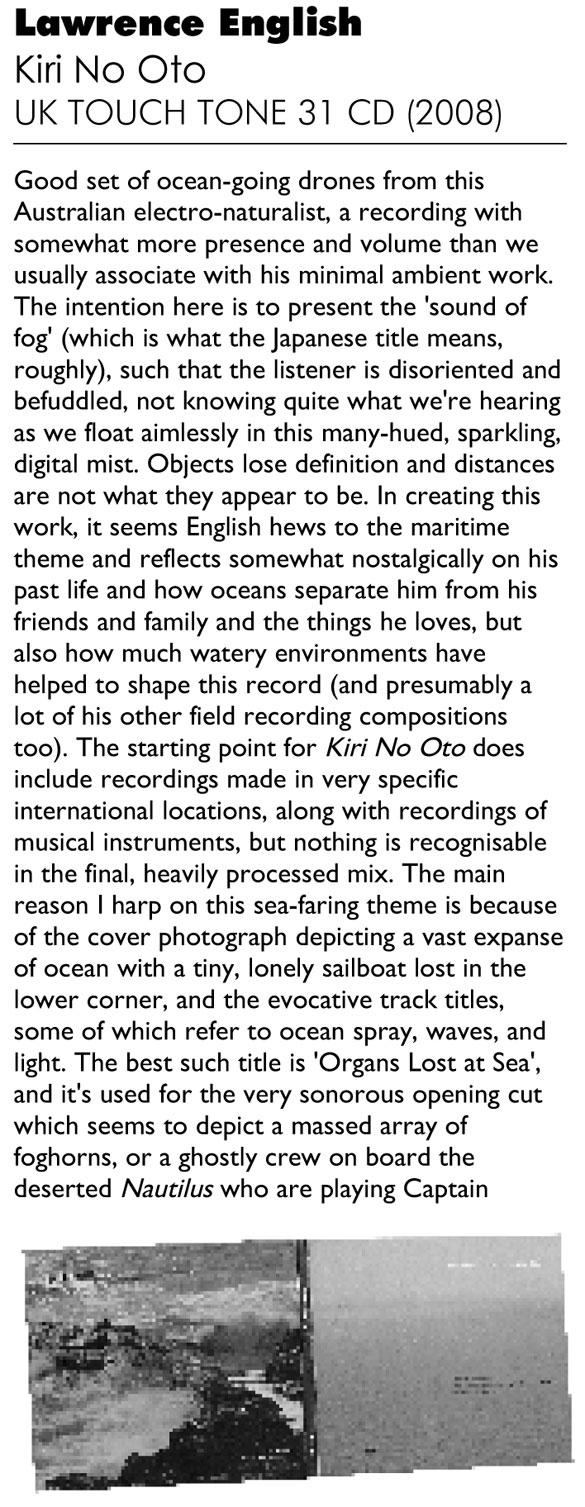
Hawai (Chile):
Su disco para Touch es otra cosa, similar tal vez, pero diferente. “Kiri No Oto”, traducido del japonés como “el sonido de la niebla”, nos muestra al English creador. Echando mano a, entre otras cosas, filtros análogos, instrumentos, distorsión “armónica” y, otra vez, grabaciones de campo –esta vez de Polonia, Nueva Zelandia, Australia y Japón–, hay acá una manipulación que no estaba presente en su otro disco. En este nos encontramos con ambientes densos y nada suaves, y esto se percibe nada más comenzar la travesía (“Organs Lost At Sea” y “Soft Fuse”). Hay quietud y a la vez desplazamiento. Movimientos (largos) reposados no en un tema, sino entre más de uno, siempre inmerso en una atmósfera pesada, a excepción del alivio de “Allay”. No podría haber sido otro el título pues, efectivamente, “Kiri No Oto” es como oír la niebla, una niebla inhóspita, o más precisamente, ver dentro de ella. No es mucho lo que se puede distinguir, las figuras cambian, los trazos se alteran, la poca luminosidad distorsiona el paisaje. Eso mismo sucede con los sonidos. Eso es lo que consigue Lawrence English en un excelente trabajo, otro más de Touch.










